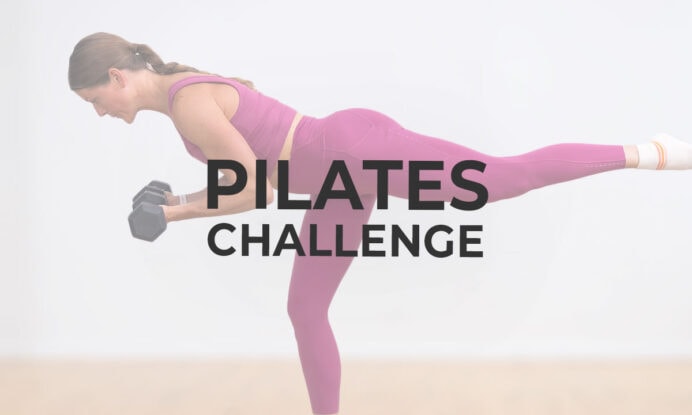
35-Minute Full Body Circuit Workout
This full-body circuit training workout is designed to target all major muscle groups – upper-body, lower-body and core – while boosting cardiovascular endurance and functional strength. We’ll combine strength and cardio exercises in back-to-back circuits with minimal rest, making this scalable for all fitness levels. The format keeps you moving, challenges endurance and improves overall strength and coordination.
As a fitness trainer and a mom, I’m always looking for workouts that are efficient, effective and functional. I want to prioritize movements that make me stronger in everyday life, not just in the gym. That’s exactly why I love full-body circuit training, and why I’ve created so many circuit-style “shred” workouts
Full-body circuit workouts allow you to move through a series of exercises targeting every major muscle group (upper-body, lower-body, core and often cardio). Circuit training workouts are designed to keep you moving with minimal rest between exercises, which keeps your heart rate up while building strength and endurance. Think of it as a way to get the benefits of strength training and cardio simultaneously.
The great thing about this style of training is its functional fitness benefits. Functional fitness is all about training your body for real-life movements, like bending, lifting, twisting and jumping – things we do every day as parents, professionals or just human beings. By combining multiple muscle groups, full-body circuits improve coordination, balance and overall strength, making daily tasks feel easier.
When I taught group fitness classes, I often structured workouts in this “shred” format: 1 upper-body move, 1 lower-body move, 1 core exercise and 1 cardio move, repeated in a circuit. Alternating exercises like this allows you to lift heavy and challenge your muscular endurance without burning out a single muscle group too quickly.
If you’re a beginner, you can adapt full-body circuit workouts to your fitness level. I recommend starting with light dumbbells so you can focus on form. Aim for dumbbells you can lift comfortably for 12-15 reps without compromising your form. You can also start with resistance band or bodyweight exercises if needed. As you gain strength and confidence, you can gradually increase the weight. The beauty of circuit training is that it’s scalable, so everyone from a beginner to an advanced athlete can get a challenging, full-body workout.
What I personally love about circuit workouts is how time-efficient they are. As a busy mom, I usually don’t have much time to dedicate to the gym, but with circuits, I can hit every major muscle group, get my heart rate up and feel accomplished in 30-40 minutes. Plus, because the workouts are varied and dynamic, I never get bored.
If you’re looking for a strength workout routine that improves endurance and makes you feel strong in your everyday life, full-body circuit training is a great option. You’ll leave each session one step closer to reaching your fitness goals.
MEMBER SPOTLIGHT
MEET KRISTI!
For more exclusive workout challenges, live workouts, nutrition chats, and direct support from our team, become a YouTube Member today.
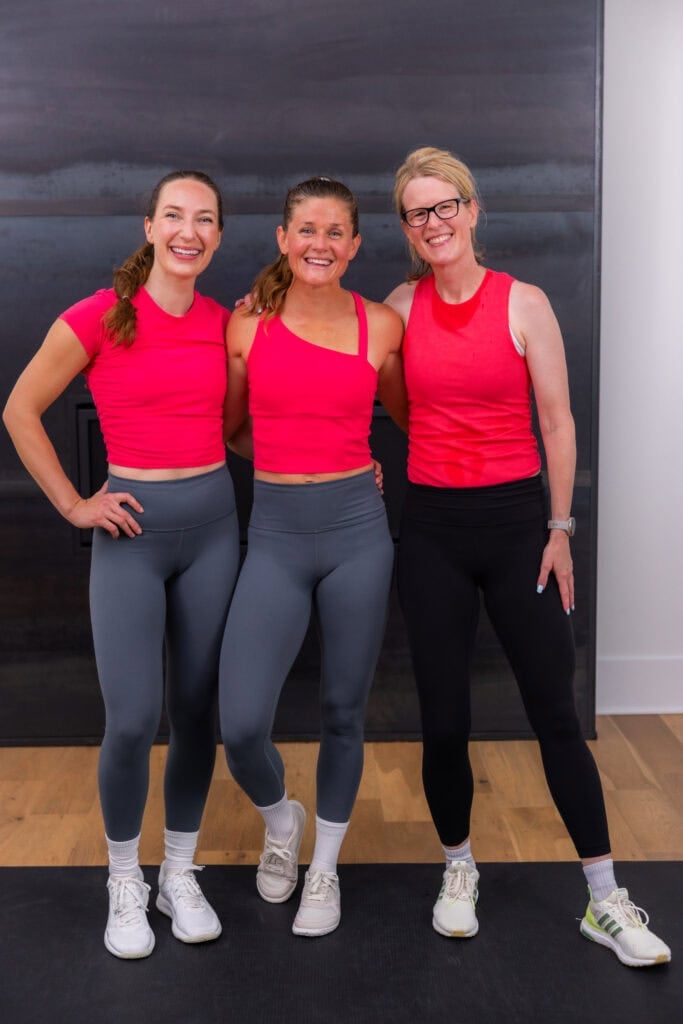
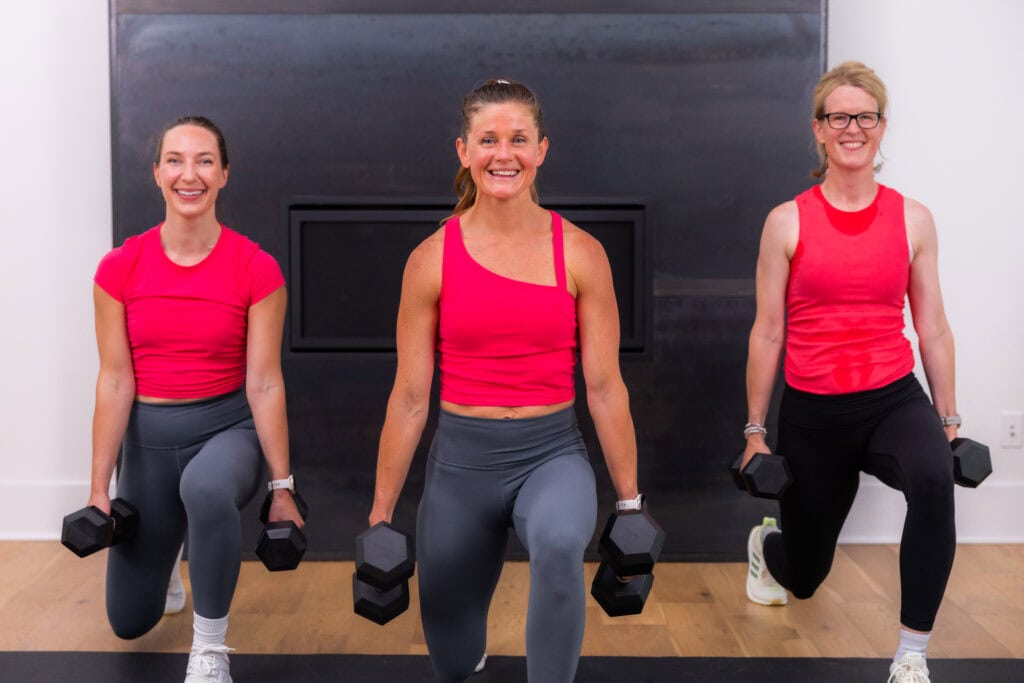
Read A 5-Star Review ⭐⭐⭐⭐⭐
“THIS WAS WONDERFUL!! Low energy today and got through it with all of your good ENERGY and ENCOURAGEMENT. Love the tips and guests!!!”
— Mac S.
Workout Specifics
This 35-minute full-body strength circuit combines 12 of the best exercises you can do at home with minimal equipment. Modifications are provided for both beginners and advanced athletes to scale the workout to meet your needs.
I recommend adding dumbbell workouts like this one to your home workout plan 1-2 times a week to improve endurance, speed, agility and cardiovascular conditioning.
Workout Equipment
Medium to Heavy Set of Dumbbells. I recommend between 5-25 lbs, depending on your fitness level. I’m using 15-25 lb dumbbells in today’s full-body workout.
Workout Instructions
Follow along with the guided 35-Minute At-Home Circuit Workout on YouTube, led by me — your certified personal trainer, Lindsey Bomgren.
Your Workout Looks Like This:
- Guided Warm-Up and Cool-Down
- 3 Full-Body Circuits
- 4 Exercises Per Circuit
- Timed Intervals (40-second work periods, 20-second rest periods. Perform as many reps as possible while maintaining proper form during the timed intervals.)
- Repeat each circuit x2 sets
Note: Today’s workout is an updated version of a popular full-body circuit workout with weights. I re-filmed this workout to improve the audio and video quality and share some new moves. If you try both, I’d love to know which version is your favorite!
Workout Outline
1. Lateral Raise
Targets: The lateral deltoid, anterior deltoid and posterior deltoid.
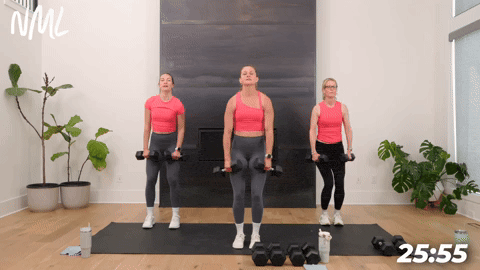
How to Do a Lateral Raise
- Stand with your feet shoulder-width apart and a slight bend in your knees. Hold a dumbbell in each hand at hip level, palms facing in towards each other.
- Engage your core as you lift the dumbbells out towards your sides, keeping a slight bend in the elbows. Lift the dumbbells just to shoulder height.
- Slowly lower the dumbbells to the starting position.
Modification: Perform alternating single-arm lateral raises, raising just one dumbbell at a time.
2. Uneven Dumbbell Squat
Targets: Glutes, quads, hamstrings and core.
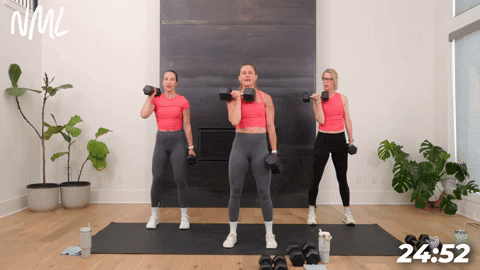
How to Do an Uneven Dumbbell Squat
- Stand with your feet hip-width apart, knees slightly bent.
- Hold one dumbbell in your right hand at your right side. Hold another dumbbell in your left hand in a front rack position at your left shoulder.
- With your weight in your heels, sit your hips back as you lower into a squat, striving for a 90-degree angle between your hips and knees.
- Drive through your heels, squeezing your glutes to stand tall.
3. Push-Up and Shoulder Tap
Targets: Chest, shoulders, triceps, back, abs, obliques and core muscles.
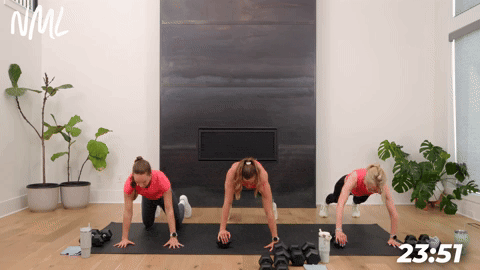
How to Do a Push-Up and Shoulder Tap
- Start in a high plank position with your shoulders stacked over your wrists, feet hip-width apart. Place your left hand on the head of a stable dumbbell and your right hand on the ground.
- Hold this high plank position, maintaining a straight line with your body, gaze slightly in front of you.
- Slowly lower your chest down towards the ground as your elbows fall back towards your body (not out to the sides).
- Once at the bottom of your push-up, exhale as you push back up into high plank position.
- Then, perform a single-sided shoulder tap by tapping the left shoulder with the right hand.
Modification: Perform modified push-ups from your knees. You can omit the balance challenge by placing both hands on the ground rather than placing one hand on the head of a dumbbell.
4. Dumbbell Burpee
Targets: Legs, hip flexors, calves, arms, shoulders, back, abs and core.
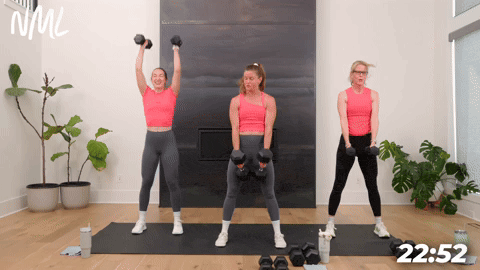
How to Do a Dumbbell Burpee
- Stand with your feet hip-distance apart, or a little wider. Hold 2 dumbbells in front of you, at your hips.
- Engage your core and lower your hips down to the bottom of a squat as you place the dumbbells on the ground between your feet.
- Step or jump both feet back to a high plank position. Make a straight line with your body from head to feet.
- Pause for a moment, then, in one explosive movement, jump both feet forward and land just outside your hands or dumbbells.
- You should land in a deep squat from which you explosively stand up, pulling the dumbbells up.
Modification: Option to sub a squat thruster. You could also make the dumbbell burpee low-impact by stepping back to plank and walking your feet back into the bottom of the low squat (instead of jumping back and jumping in).
5. Back Row and Bicep Curl
Targets: Both the lower back and upper back, specifically the lats and rhomboids, as well as the bicep muscles.
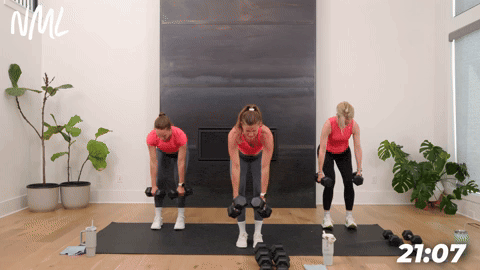
How to Do a Back Row and Bicep Curl
- Stand with your feet hip-width apart and your knees slightly bent. Grip a set of dumbbells, palms facing each other.
- Hinge at the hips until your chest is parallel to the floor.
- Pull the weights back towards your hips. This is a back row. In this variation, perform 4 bent-over back rows. Feel your shoulder blades squeeze together with each row.
- After the fourth row, stand tall and perform 4 standing hammer curls. Squeeze your bicep muscle to curl the weights up to shoulder height as you exhale.
6. Split Lunge
Targets: Legs, glutes, quads, hamstrings and core.
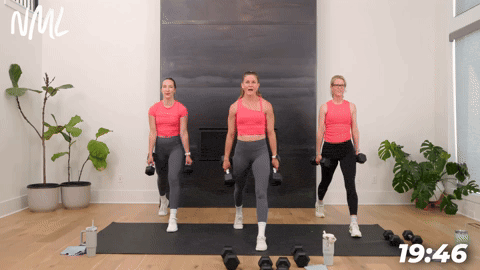
How to Do a Split Lunge
- Start standing with your feet hip-width apart, holding a dumbbell in each hand at your sides.
- Step your right leg back into a lunge position. Imagine your feet are on train tracks – front left foot planted on the mat and back right toes on the mat. Feet stay planted in this position throughout the entire movement.
- Lower your right back knee towards the mat until your front thigh is parallel to the mat. Both knees bent at 90 degrees. Shoulders remain stacked over hips.
- Drive up through your front heel to stand tall, returning to the top of the movement.
Modification: If lunges are uncomfortable, check out these alternative exercises.
7. Single-Leg Deadlift and Reach
Targets: Legs, glutes, quads, hamstrings and core.
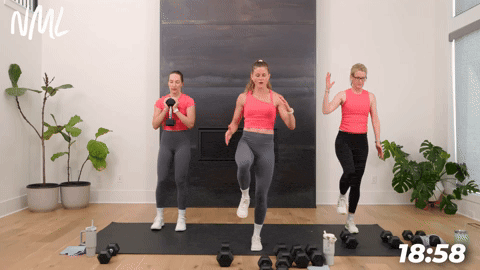
How to Do a Single-Leg Deadlift and Reach
- Start standing with your feet hip-width apart, a set of dumbbells placed on the floor in front of you (a dumbbell just outside each foot).
- Shift your weight onto your right foot and lift your left knee into a knee drive so it’s in line with your hip. Engage your core to maintain balance.
- Using just your bodyweight, hinge forward at the hips, sending your left leg long behind you as you reach your left hand across your body to tap the dumbbell on the ground just outside your right foot. Keep your back flat and chest square to the floor.
- Drive through your right heel to return to standing, pulling your left leg back in so the knee is lifted in line with your hip.
- Hinge at the hips again, this time reaching your left hand down toward the dumbbell placed near your left foot. Keep your right leg strong and core engaged.
- Stand tall to return to the starting position and repeat.
Modification: Omit the balance challenge by performing standing goblet marches.
8. Pogo Bound and Lunge Drop
Targets: Legs, glutes, quads, hamstrings and core.
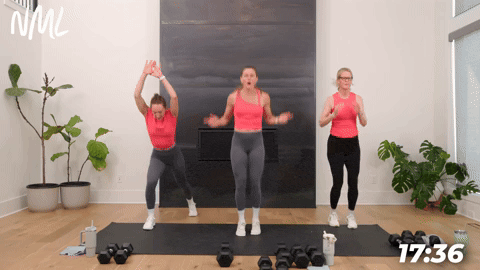
How to Do a Pogo Bound and Lunge Drop
- Start standing tall with your feet hip-width apart, arms relaxed at your sides.
- Perform 2 quick pogo hops, keeping your feet parallel and staying light on the balls of your feet.
- After the second hop, step your right foot back and lower into a reverse lunge. Both knees bend to 90 degrees, with your left thigh parallel to the floor and shoulders stacked over hips.
- Drive through your front left heel to return to standing tall.
- Perform 2 more pogo hops in place.
- Step your left foot back into a reverse lunge, lowering until both knees are bent at 90 degrees.
- Push through your front right heel to stand tall, returning to the starting position.
- Continue alternating sides, repeating the hop-to-lunge pattern.
Modification: Reduce the impact by performing alternating knee slams.
9. Lateral Lunge
Targets: Legs, glutes, quads, outer thighs and inner thighs.
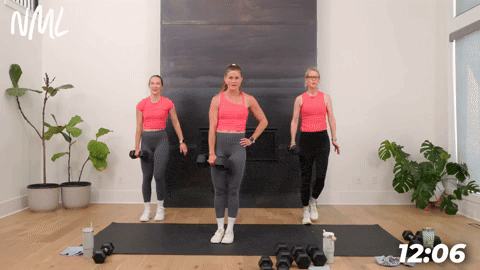
How to Do a Lateral Lunge
- Start standing with your feet hip-width apart. Hold one dumbbell in your left hand.
- Take a large step to the right with your right leg as you sit your hips back, bending your right knee while leaving your left leg straight. Think of performing a single-leg squat with your right leg while your left leg remains straight. Knees and toes are pointing forward.
- Drive off your right foot to reverse the movement, standing back up to the starting position (as you pull your inner thighs together).
10. Skull Crushers
Targets: Triceps and core.
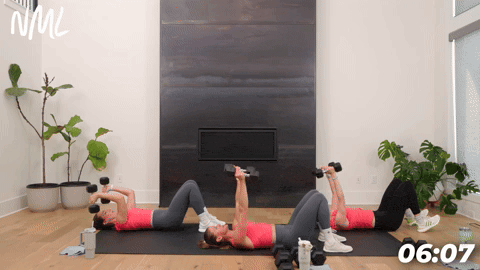
How to Do a Skull Crusher
- Lie flat on the ground with your legs bent at 90 degrees. Hold one dumbbell in each hand and extend your arms so the dumbbells are directly overhead (your palms are facing one another).
- Bending at the elbows, slowly lower the dumbbells towards your head.
- Press the dumbbells back overhead to return to the starting position.
11. Chest Fly and Knee Tuck
Targets: The chest (pectoralis major and pectoralis minor), triceps, upper abs, lower abs, obliques, transverse abdomen and hip flexors.
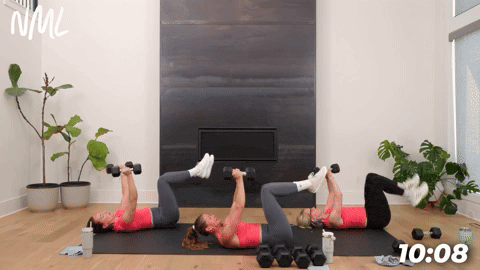
How to Do a Chest Fly and Knee Tuck
- Lie on your back, knees bent at 90 degrees and stacked over your hips. Hold one dumbbell in each hand, palms facing in towards each other, and arms extended above your shoulders.
- Inhale to brace your core, pressing your lower back into the mat as you slowly open your arms (slight bend in the elbows), lowering the dumbbells in a wide arc until they reach shoulder level (or the ground). Your elbows should remain soft and not overextended. As you perform the chest fly, simultaneously straighten your legs, kicking your heels out away from your body. The lower your heels, the more difficult this exercise will be.
- Exhale as you pull the dumbbells back to the starting position, squeezing your chest muscles together. As you pull the dumbbells back, simultaneously pull your knees in, performing a knee tuck.
Modification: Option to omit the leg extension, keeping the knees tucked in at 90 degrees as you perform the chest fly. Alternatively, reduce the intensity by sending one leg long at a time.
12. Skaters (3-Skate and Jump Variation)
Targets: Legs, glutes (outer gluteus medius), hips, calves, quads and core.
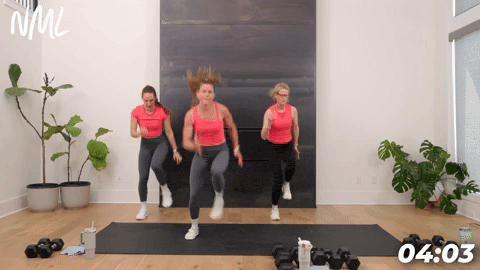
How to Do a Skater (3-Skate and Jump Variation)
- Start standing in an athletic stance, feet hip-width apart, knees slightly bent, core engaged.
- Push off your right foot to bound laterally to the left, landing in a loaded skater position on your left foot. Left knee bent, right leg tracking behind your left foot.
- Drive off your planted left foot to bound laterally to the right, landing softly on your right foot. Right knee bent, left leg tracking behind your right foot.
- Push off your right foot to bound back to the left for the third skater. Land softly on your left foot, left knee bent, right leg tracking behind.
- From the third skater position, jump directly up on your left foot. Land softly, absorbing the impact through your left leg.
- Repeat the sequence, starting with the opposite side.
FAQs
Cardio is any aerobic activity that keeps your heart pumping and your lungs working harder (think running, cycling or swimming). Circuit training is a mix of different exercises done in a sequence, usually with minimal rest. A circuit workout can include both HIIT cardio exercises and strength exercises. While cardio is typically just 1 type of aerobic workout, circuit training combines high-intensity cardio and strength into 1 session.
Yes, circuit training is good for beginners. Circuit workouts can be modified for any fitness level. They offer an effective way to work through foundational exercises while improving cardiovascular fitness and increasing muscular endurance. Adjust the intensity and duration of the exercises to match your fitness level.
The 3-2-1 workout method combines 3 days of strength training, 2 days of barre/Pilates and 1 cardio or HIIT workout. This workout method can build overall strength, improve flexibility and boost cardiovascular health without leading to burnout.
More Workouts
Full-BodyPin This Total-Body Circuit Workout
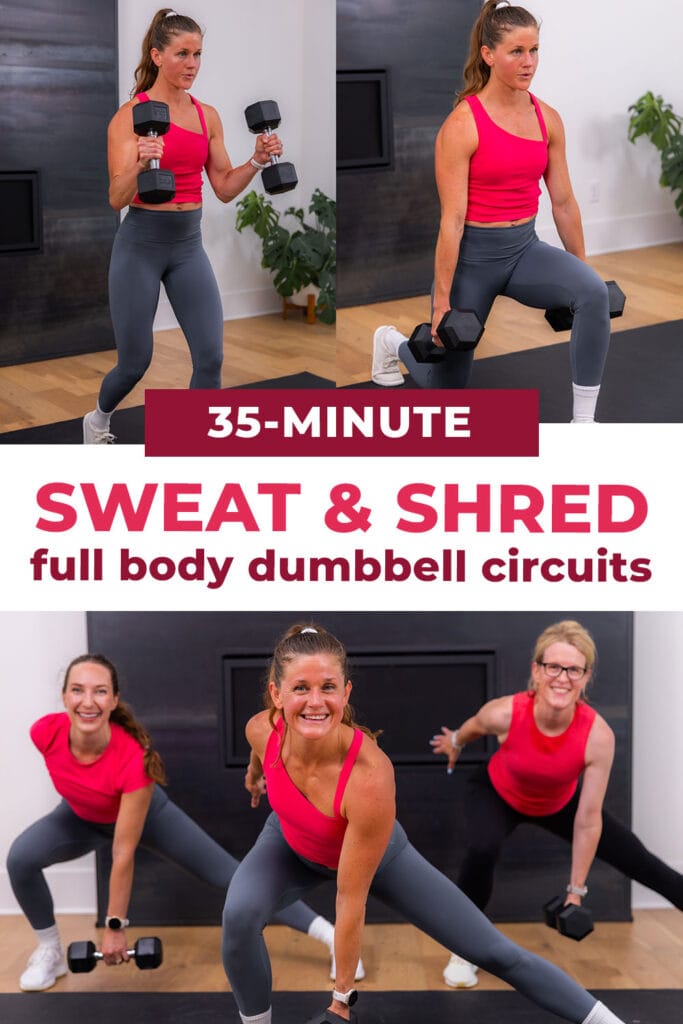










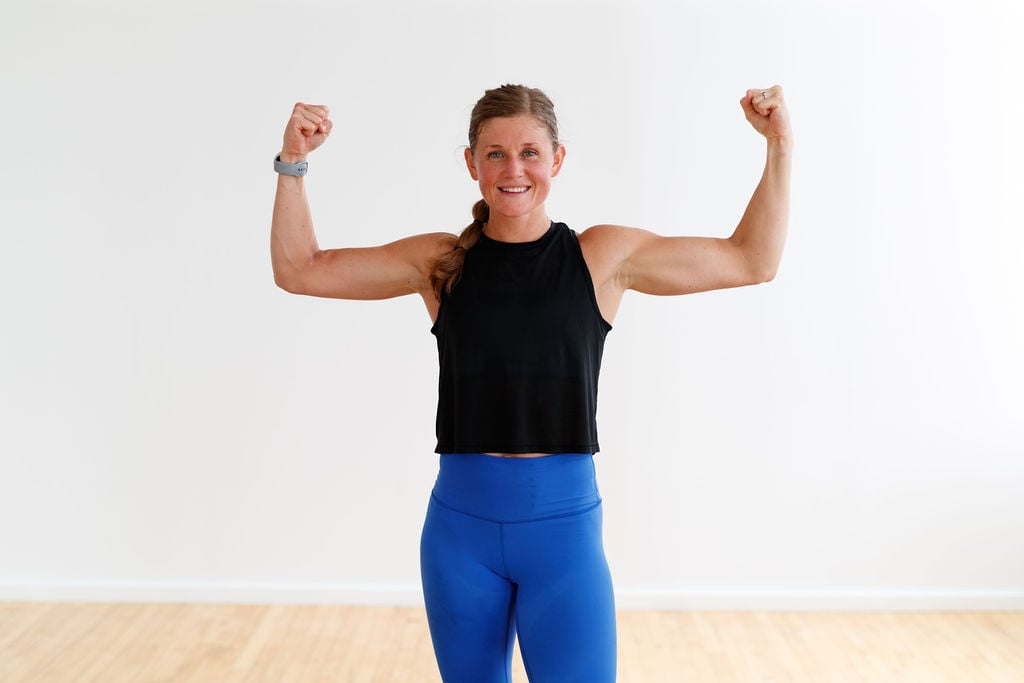
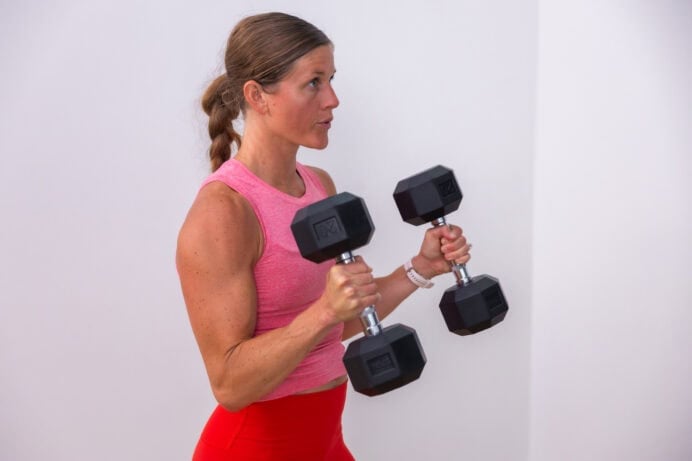
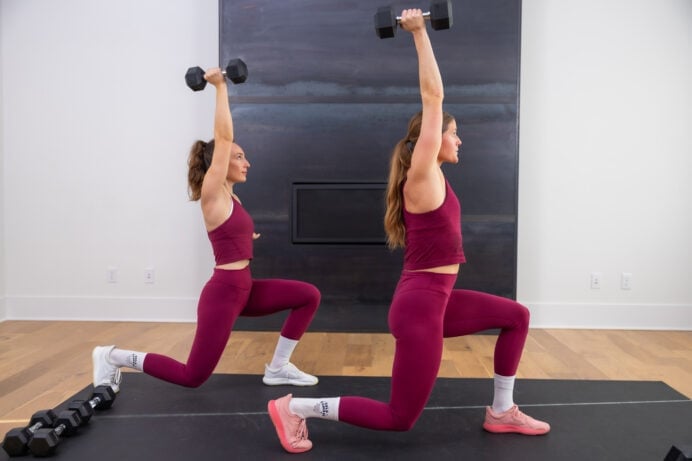
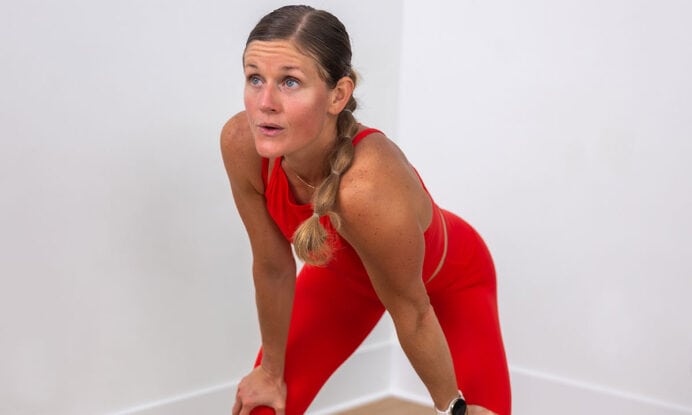
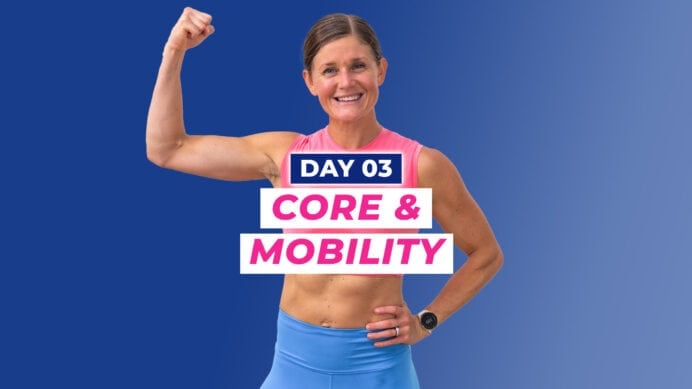
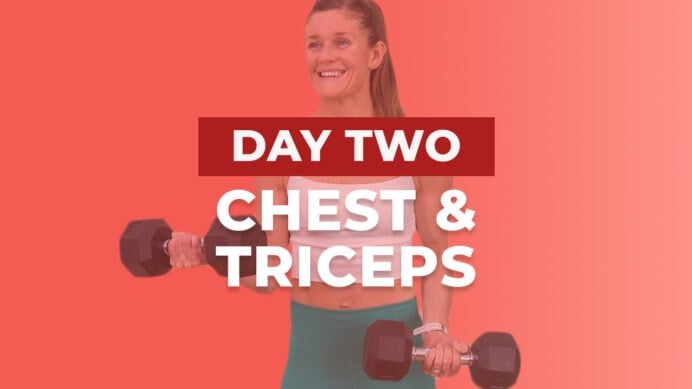
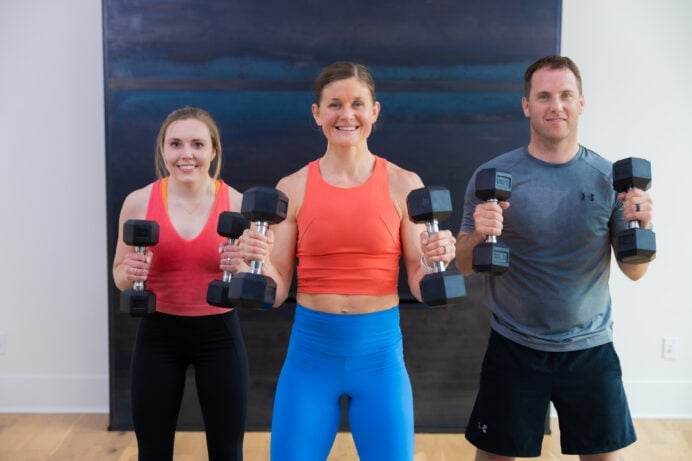
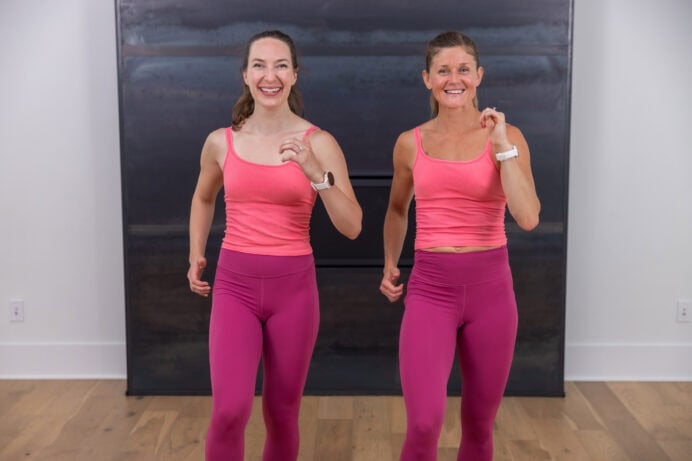
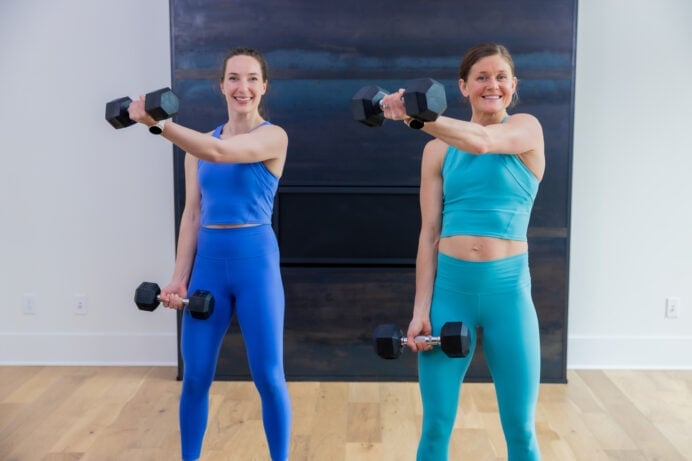
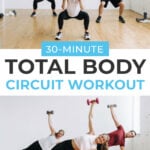
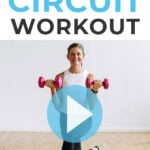
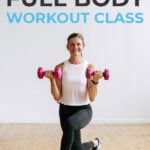
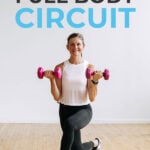
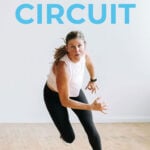
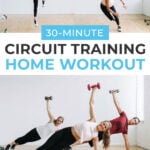
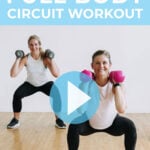
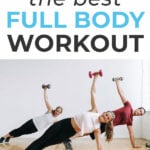
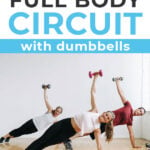
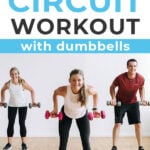
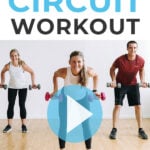
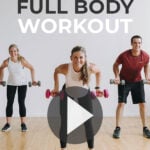
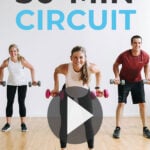
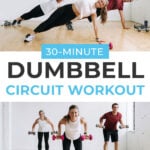
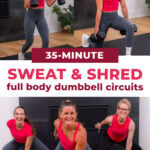
Got this on Pinterest..cannot say how good it is as .video doesn’t play…
Hi Sandi! So glad you found this workout on Pinterest and you may have trouble viewing the video on my site due to having your ad blocker turned on. Try watching this video on YouTube here — https://youtu.be/L8Fbfx-Uv6I
love your workouts they are keeping me going .Please keep the full body workouts with dbells. You are my inspiration. God bless you.
Rosa! So glad you’re loving the workouts! Keep up the great work and keep coming back for more! -Lindsey